Hi all, I’m currently back in Harbin, Heilongjiang province, my parents’ hometown. Spending the next few weeks with relatives, and heading to Seoul (my first time in Korea!) at the end of the month. To prioritize family time and an upcoming deadline for a project I’m working on, I’ll be taking a break from Substack for two months and pausing all paid subscriptions. Thanks for reading, and see you in October!
This summer, I tried to document every wild mushroom variety I could find in the markets here in Dali, Yunnan, focusing on commonly eaten species that are generally safe for consumption (certain mushrooms are questionable when it comes to digestibility). I cooked and ate each one to record their flavor, and also asked the vendors how they prepare them.
More than 800 varieties of edible mushrooms grow in Yunnan, the most biodiverse province in China; this is just a small selection and representative of June-August in my town (located in the southwestern part of the province). I will be updating this list with additional fall varieties as I find them.
Yunnan’s Wild Edible Mushrooms
June - August 2024
1) Ganbajun, “aged beef fungus” 干巴菌
Thelephora ganbajun | black ganba fungus
Market price: 320-440 RMB per kilogram ($22-31/pound)

Ganbajun is one of the most sought after wild mushrooms in Yunnan Province, called ‘lord of the fungi’ (菌中霸王). It’s a rare coral fungus species highly endemic to Yunnan, growing in pine forests. The ganba was only officially identified by professional mycologists in 1987.
Locals have obviously been eating it for much longer. The fungus can be found growing in dark clusters, ranging from green-tinged to tan to inky black when mature. You rub the mushrooms with dry flour to scour off any pine needles and dirt, then dunk them under water and rinse 5-8 times until clean. When fried, ganbajun has a beef jerky aroma; it’s named after ganba (干巴), Yunnan dry-aged beef.
Eating notes: best paired with garlic and chiles. Shrivels up quickly when it cooks and tastes a bit like ink. Since it falls apart quickly it’s best stir-fried with other shredded ingredients, cooked into fried rice, or fried in chili oil and garlic and served with rice noodles.
2) Jizong, “chicken mushroom” 鸡纵菌
Termitomyces albuminosus | chicken mushroom, umbrella mushroom, termite mushroom
Market price: 140 RMB - 240 RMB per kilogram (about $10-$17/pound)

Jizong is an interesting one: it has a symbiotic relationship with termites.
The elusive fungus only grows in termite mounds in the meadows and forest peripheries in mountainous Yunnan, Guizhou, and Guangxi, most famously in Qianxinan prefecture (黔西南), where there are 7 known varieties. Termites create the perfect substrate of digested wood matter to cultivate the mycelium; they consume the mushrooms but also help disperse their spores. The pencil-like stalks are firm, fat and crunchy with fine white flesh.
Eating notes: Texture surprisingly like a roasted carrot or parsnip. Very sweet on the tongue. Flavor like an enoki mushroom— sweet, clean and rather crunchy. Locals cook them in broths as they can withstand long cooking times and their fragrance intensifies with simmering. Also delicious sliced and stir-fried.
A taxonomically related variety is called ‘small jizong,’ 小鸡枞 or ‘black-skin jizong’ 黑皮鸡纵. These are cultivated widely across China and a fraction of the price of wild jizong. They’re smaller, dark gray and velvety, and the root end is usually shaved to a tip. Locals call these man-made (rengong) jizong. You’ll find them in hot-pot restaurants in almost every Chinese city.
3) Songrong, “pine mushroom” 松茸
Tricholoma matsutake | matsutake
Market price: 100 RMB to 1000 RMB / kilogram (ranges from $7-$70/pound)
Foraging for pine mushrooms is a lucrative summer hustle for villagers, who sell them to exporters. Most Yunnan matsutake end up in Japan, where it’s highly valued. Ironically, locals don’t particularly care for them as they consider the flavor too grassy and musky, not as intensely savory as porcini varieties. Yunnan villagers once used fed matsutake to their pigs to help them mate. When the mushrooms started commanding very high prices in other countries, they paid more attention. Today it’s a major export.
Prices vary; larger stalks can be cottony or conceal insects; the denser, wine-cork sized matsutake are generally more valuable.
Eating notes: Minerally and crunchy. A strong piney aroma. Can be metallic depending on mineral compounds in the surrounding earth. Often eaten raw dipped in soy sauce, or thinly shaved and cooked in broth with chicken, goji berries, etc.


At this private dinner the chef showed us her favorite way to prepare them: thinly sliced and sautéed briefly. Even seasoned lightly with salt, they had a powerful savoriness reminiscent of goat cheese (chèvre).
Russula
4) Honggu, “red mushroom” 红菇
Russula vinosa | darkening brittlegill, southern red ginseng
Market price: 240 RMB per kilogram ($17/pound)
Unlike many red-capped members of the russula genus, this red mushroom is edible and mild-tasting, highly prized in Yunnan for its nutritional value. Women often eat it in postpartum care after childbirth, as it’s beneficial for blood circulation. Honggu is also called “southern red ginseng” (南方红参).
The umbrella cap is flat and sticky when young, matte/velvet to the touch and dark red on the edges, with distinct gills. The flesh is white, thick and solid, and often eaten by insects. Fresh honggu are rare and expensive, and it’s impossible to cultivate them— dried honggu are often exchanged as gifts.
Eating notes: Firm and chewable, like white chicken meat. The taste is a little spicy and mineral-like. TCM practitioners soak the dried honggu and cook it into a soup with yam, ribs, ginger, and cooking wine as a “beauty soup,” or with local chicken in stews.
5) Qingtoujun, “green head mushroom” 青头菌
Russula virescens|green-cracking russula, green brittlegill, 绿菇 lugu, 青菌 qingjun
Market price: 240 RMB per kilogram ($17/pound)
Despite its moldy appearance, qingtoujun makes for good eating. It’s considered one of the best edible mushrooms of the genus Russula and beloved among the locals.
The cap is initially spherical, quickly flattened and often slightly concave as it grows, with a light green to gray color. Qingtoujun grows in western Yunnan, under pine or coniferous trees during the rainy season from June to September.
Eating notes: mild, fruity, a little sweet. Texture is soft and chestnut-like. Can be eaten raw in liangbancai, roasted with a little salt, or stir-fried with chiles.
6 ) Heihuzhang, “black tiger’s paw mushroom” 黑虎掌
Sarcodon imbricatus | shingled hedgehog, scaly hedgehog, hawk’s wing mushroom
Market price: 220 RMB per kilogram ($15/pound)
There’s barely any information about heihuzhang on the English-language internet (it’s related to a better-documented species, the hawk’s wing mushroom). Heihuzhang grows in Yunnan and it’s a kind of tooth fungus, capable of growing up to a foot-long or more. It’s known locally as the black tiger’s paw mushroom. The handsome sturdy stems are buff in color with dark-scaled caps. Fresh heihuzhang are only available for a month; dried are more affordable.
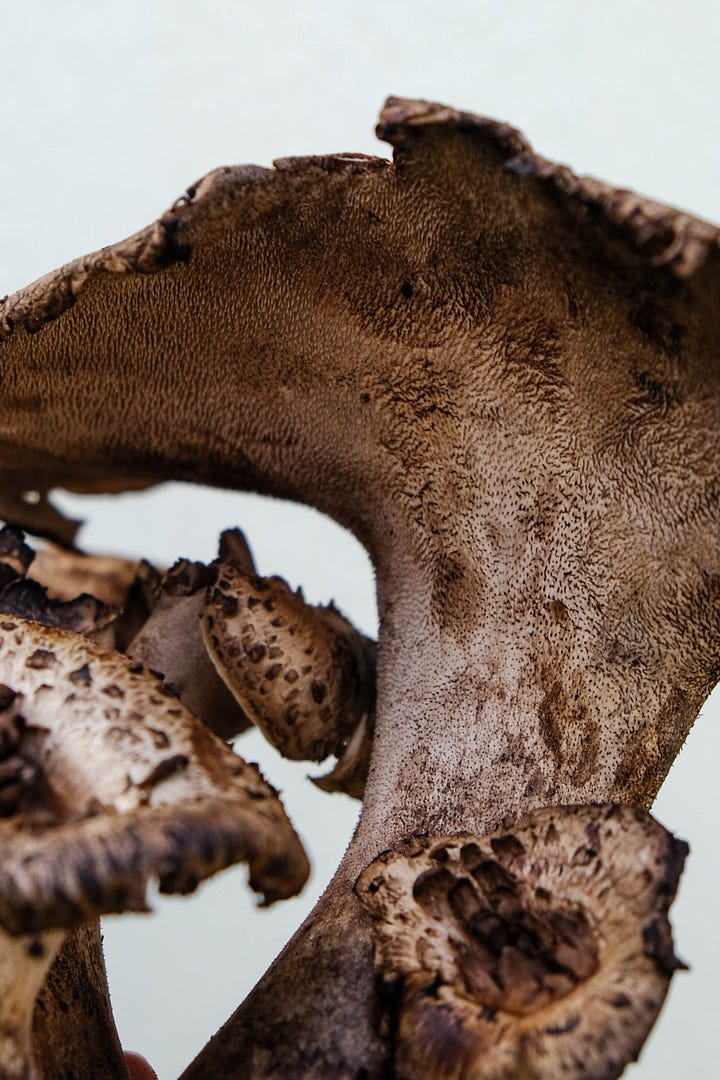
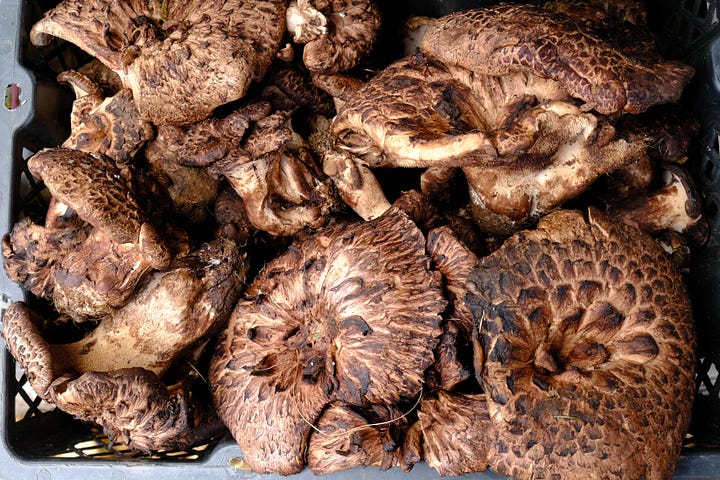
I ate dried heihuzhang for the first time at this dinner, where it was frizzled in oil, and fell in love with the flavor. When you cut the mushroom open, it’s consistent in color and texture from stem to cap. It smells nice, like chocolate and walnuts.
Eating notes: Slightly woodsy, no seafood or meat aromas, just intense savoriness. In my opinion, this is the most essentially mushroom-tasting mushroom there is. The texture is chewy but not tough. You can slice it up and cook it straight, although it’s best in soups, pickled or dried, or turned into flavorings. In Korea, it’s used to make tea (neungi-cha, scaly hedgehog tea).
7) Huanghuzhang, “yellow tiger’s paw mushroom” 黄虎掌
Hydnum repandum | hedgehog mushroom
Market price: 210 RMB per kilogram ($15/pound)

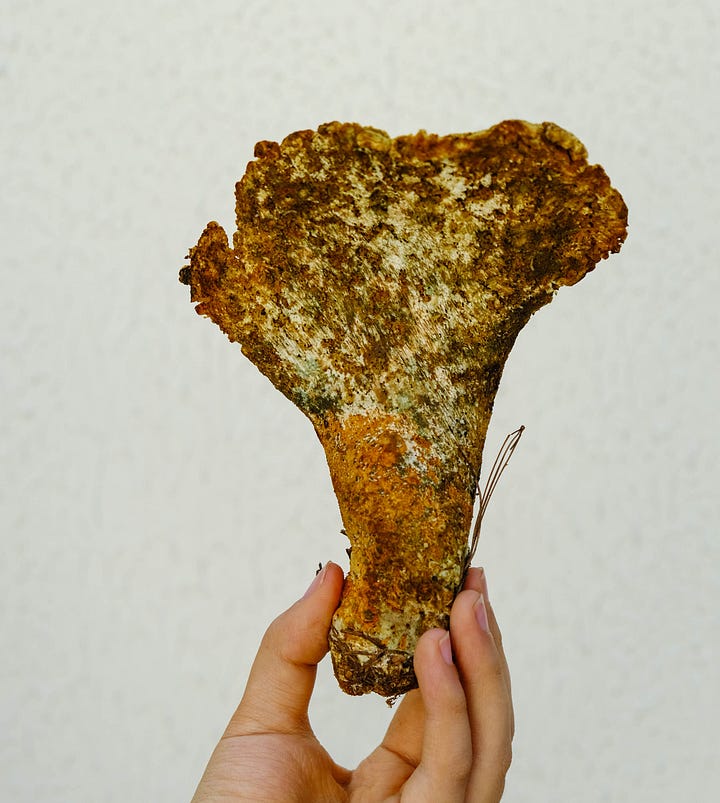
Paw-shaped and mottled, this large mushroom grows at altitudes up to three thousand meter near the Tibetan prefecture and Shangri-la (an actual town named after the fictional location). The closest known ID is Hydnum repandum or hedgehog mushroom, but molecular studies have shown that the current species concept for H. repandum needs revising, as the specimens in southwestern China are different from those found in Europe and North America.
Eating notes: The initial aroma and flavor reminds me of a white puffball, but the texture is like a parsnip, fibrous and meaty and a bit starchy. It’s nutty and sweet. Locals cut the mushroom into slices and stir-fry it with green hot chiles, or stew it in aromatic soups.
Boletes
8) Meiwei niugan, “delicious taste porcini” 美味牛肝菌
Boletus meiweiniuganjun | Yunnan porcini
Market price: 80-140 RMB per kilogram, $7-10/pound
I wrote about foraging for these mushrooms in a previous post: Foraging for Yunnan boletus. It was extraordinarily delicious, the best mushroom I’ve tasted. Like the other varieties of boletus (see below), there are no toxic lookalikes, so these are reasonably safe to forage and consume.
Eating notes: Savoriness level: beef fat. The mushrooms stay crunchy, even after cooking for a long time in a braise or soup. They taste overwhelmingly fragrant and rich in flavor, and the aftertaste is lightly bitter and sweet. Fresh porcini are best stir-fried with garlic, fresh green chilies, soy sauce, and bean sprouts. Locals recommend adding hot peppers for heat.
9) Chenxiangjun, “fragrant porcini” 沉香菌
Leccinum aurantiacum (?) | chenxiang mushroom, orange birch bolete, red-capped scaber stalk
Market price: 60-80 RMB per kilogram, $5/pound
Chenxiang jun is named after agarwood (沉香木), a fragrant and resinous wood used in incense and small carvings. It’s a member of the boletaceae family with a distinct bright orange/red cap, very similar or identical to the Western orange birch bolete or Leccinum aurantiacum. “Tastes good but affordable (haochi bugui)” is how the vendors describe it.
Eating notes: Similar to porcini mushroom (above) but rounder and more sweet in flavor, not as beef-like or aromatic.
10) Jianshouqing, ‘see hand blue’ mushroom 见手青
Lanmaoa asiatica or Suillellus luridus (Lurid Bolete)
Market price: 140-160 RMB per kilogram ($10-12/pound)
Jianshouqing is an umbrella term for various mushrooms of the boletaceae family in Yunnan that turn blue upon bruising or cutting. There are red, purple, and brown-capped jianshouqing varieties. They share a thick, club stem and a flat spongy base, either lemon-yellow or blood red.
Note: Although edible, this fungus is the most common cause of mushroom poisoning in Yunnan, occasionally reported on the local news. Symptoms are hallucinations of tiny dancing people (小人人) and small colorful mushrooms spinning, although many of these were cases where jianshouqing was ingested raw. Locals generally believe that to prevent these hallucinatory effects, you should cook the mushrooms for at least 20 minutes, and cook them with garlic.
I’ve had this mushroom about four or five times with friends and we’ve documented either 1) nothing out of the ordinary, or 2) a sense of a high not unlike being tipsy; slightly drowsy and a bit silly, with a profuse feeling of well-being. The effect lasts about 2 hours.

Eating notes: The caps have the texture of foie gras, buttery and meltingly soft, while the firm white stalks remain crunchy. A clean savory flavor. Locals cut the mushroom into slices and stir-fry them with bamboo shoot, chiles, and pork belly, or dip them into hot pot.
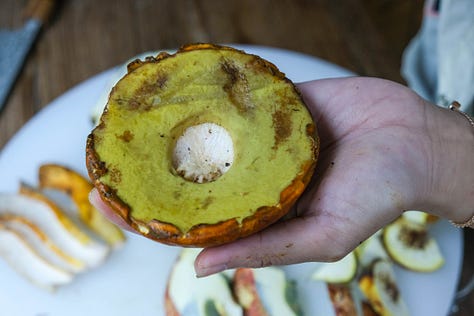
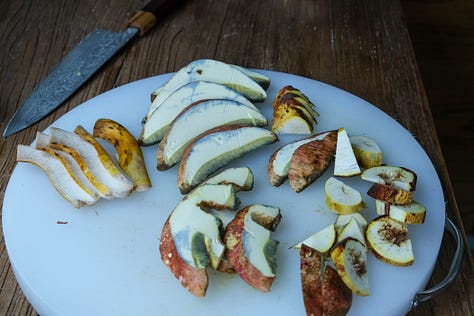

11) Zhujun, “bamboo mushroom” 竹菌
Engleromyces sinensis | bamboo ball, 竹生,肉球菌,竹包,竹球菌
Market price: 60 RMB per kg ($4/pound)
This newly documented mushroom grows out of bamboo, forming two buff-colored lobes with a purplish tint. It was described as a new species in 2010 that is found only in China, incorrectly identified as Engleromyces goetzii (from Africa) from 1958 until 2010.
Note: This species is different from zhu sun (竹荪) / “bamboo pith fungus,” Phallus indusiatus, a conical mushroom that grows a lacy skirt.
Eating notes: Extremely juicy. Liquid flows out when you bite into it. It’s somehow the same texture as a bamboo shoot??! Crisp and sweet. I simply pan-fried them for 5-6 minutes, lightly seasoned with salt, and they were delicious. They’re most often cooked into soups, known for their medicinal properties.
Miscellaneous varieties
12) Xiang gu, wild shiitake 香菇
Lentinus edodes | wild shiitake mushroom
Market price: the vendor threw these in for free
The shiitake mushroom is now globally eaten and known as a cultivated mushroom, but it also grows wild in Yunnan province and parts of Japan and Korea. This variety is umbrella-shaped with a yellowish cap and cream-colored gills.
Eating notes: Very slippery, with a softer cap than I was expecting. The stem is a lot tougher than cultivated shiitake and the flavor is more delicate.
13) Jiyoujun, “chicken fat mushrooms” 鸡油菌
Cantharellus cibarius | golden chanterelle
Market price: 40-60 RMB per kg (about $3.50/pound)
Firm and chewy, these share the same texture as an oyster mushroom. They are named “ji you jun” after the rich fat of chickens. When cooked, they don’t taste like oyster mushrooms, which have a seafood note— the savoriness here is earthier, with a lightly fruity aroma.
14) Yiwojun 一窝菌
Polyporus umbellatus (?) | Nested fungi
Market price: 70 RMB per kg ($5/pound)
I’m actually unsure what these mushrooms are. They’re commonly sold and consumed in Yunnan under the name yiwojun, literally “one cluster of fungi” or “nested fungi.” The closest known varieties they resemble are hen-of-the-woods (grifola frondosa), umbrella polypore (Polyporus umbellatus), or honey mushrooms (Armillaria mellea).
Let me know if you can help me ID them!


Eating notes: Tender but has a nice chew. Earthy and mild in flavor, similar to brown beech (shimeji) mushrooms. Most often seared or stir-fried.
Tremella (jelly fungus):
15) Wild yin-er 野生银耳
Tremella fuciformis | wild silver tremella, snow fungus, silver ear fungus, snow ear
Market price: 160 RMB per kg ($11/pound)
Wild yin-er is darker than its white cultivated counterpart, yellowish and often crisped on the edges. Also known as “snow ear” or “silver ear”, this is one of the most consumed fungi in China. They’re flavorless, enjoyed for their jelly-like texture.
Eating notes: Yin-er is traditionally eaten sweet, but can also be cooked with chicken for a savory soup. Most often you’ll find them in sweet soups (tang shui 糖水) paired with dried longan, dates, pear or papaya. The lobes expand and turn translucent after soaking. The ears are crunchy when slightly cooked, but become gelatinous and meltingly tender when simmered for hours.
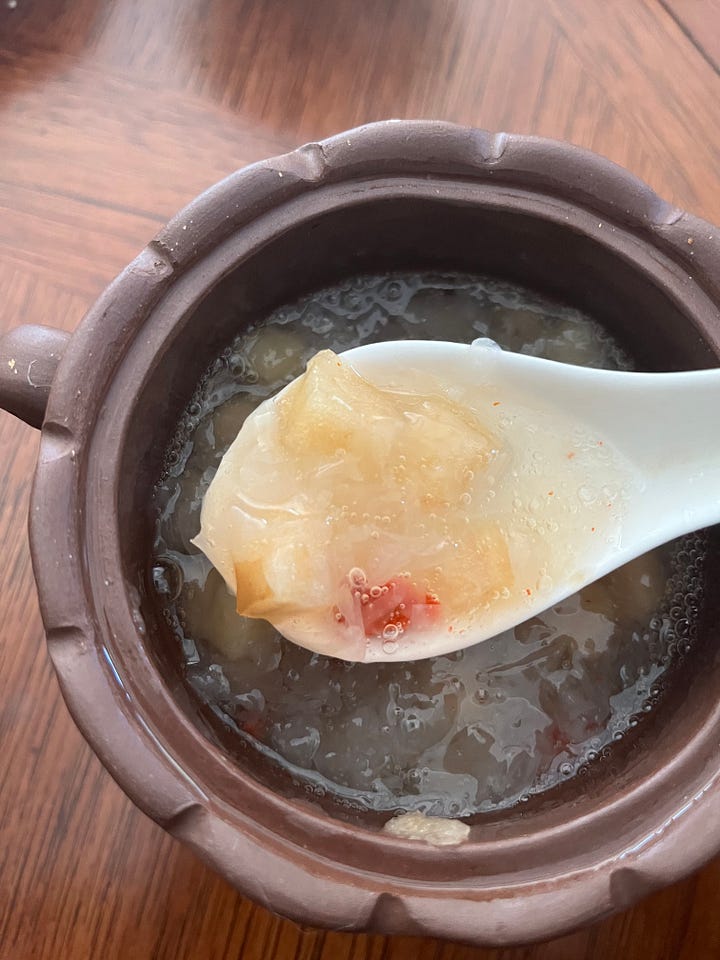
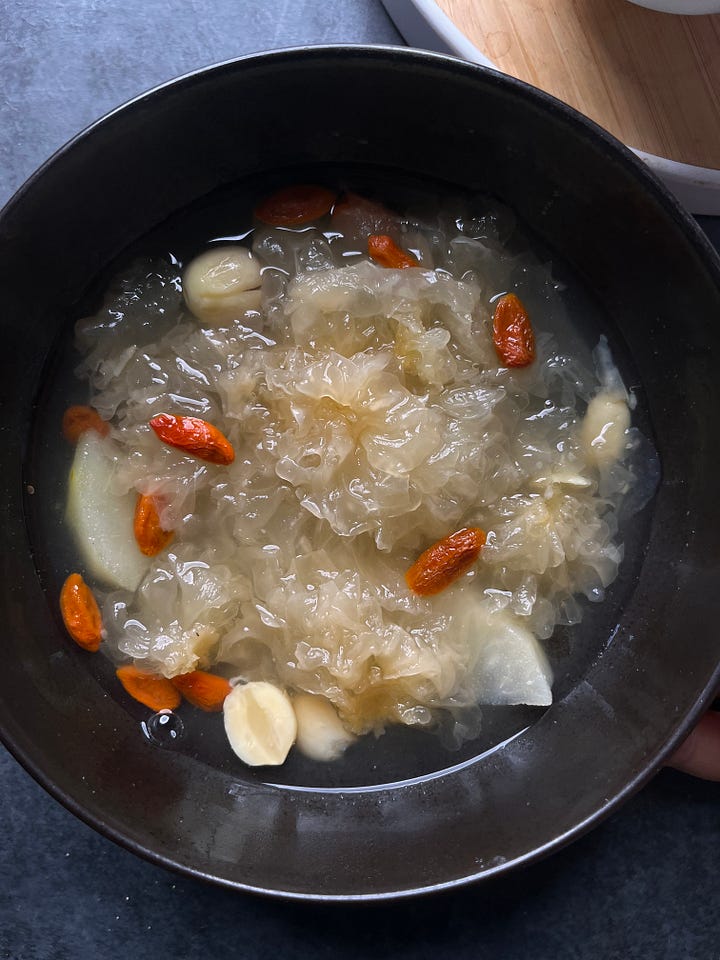
16) Jin-er, ‘golden ear fungus’ 金耳
Tremella aurantialba or Tremella mesenterica* | golden tremella, golden fungus, 黄耳 or yellow tremella, witches’ butter
*two species nearly identical, distinguishable only by host fungus
Market price: 28 RMB / 斤 ($4 a pound)
A squishy jelly fungi composed of bright orange or yellow, brain-like clustered lobes.
This is one of the few varieties of mushrooms that has a symbiotic relationship with another mushroom. Jin-er or golden fungus grows on a host fungus called corticioid fungi. Sometimes it completely subsumes it, turning parasitic instead of symbiotic. The wrinkly blob looks wet, but it’s soft and slightly velvety to the touch. It’s mostly flavorless and prized for its jelly-like texture.
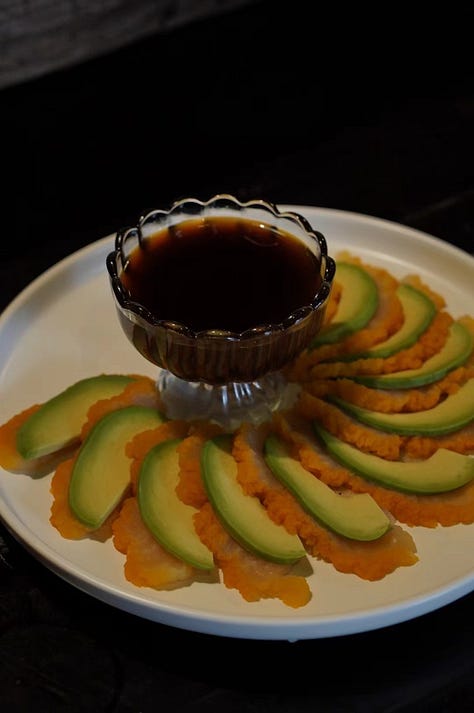

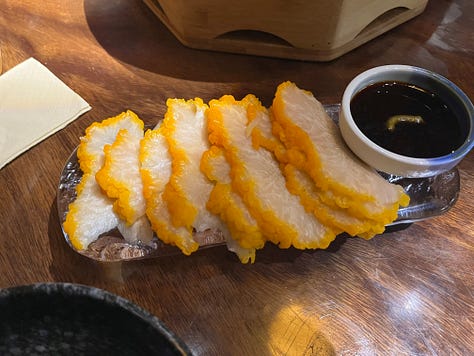
Eating notes: Jin-er is often cut into thin slices and enjoyed raw or blanched. Served with a dip of soy sauce, it’s called “Yunnan sashimi”. When cooked in soups, stews, or curries, it takes on a gelatinous texture with a slight resistance similar to pork trotter or marrow. It can also be cooked in a sweet, cooling soup with jujube red dates, lotus seed, pear, etc. similar to yin-ear (see above).







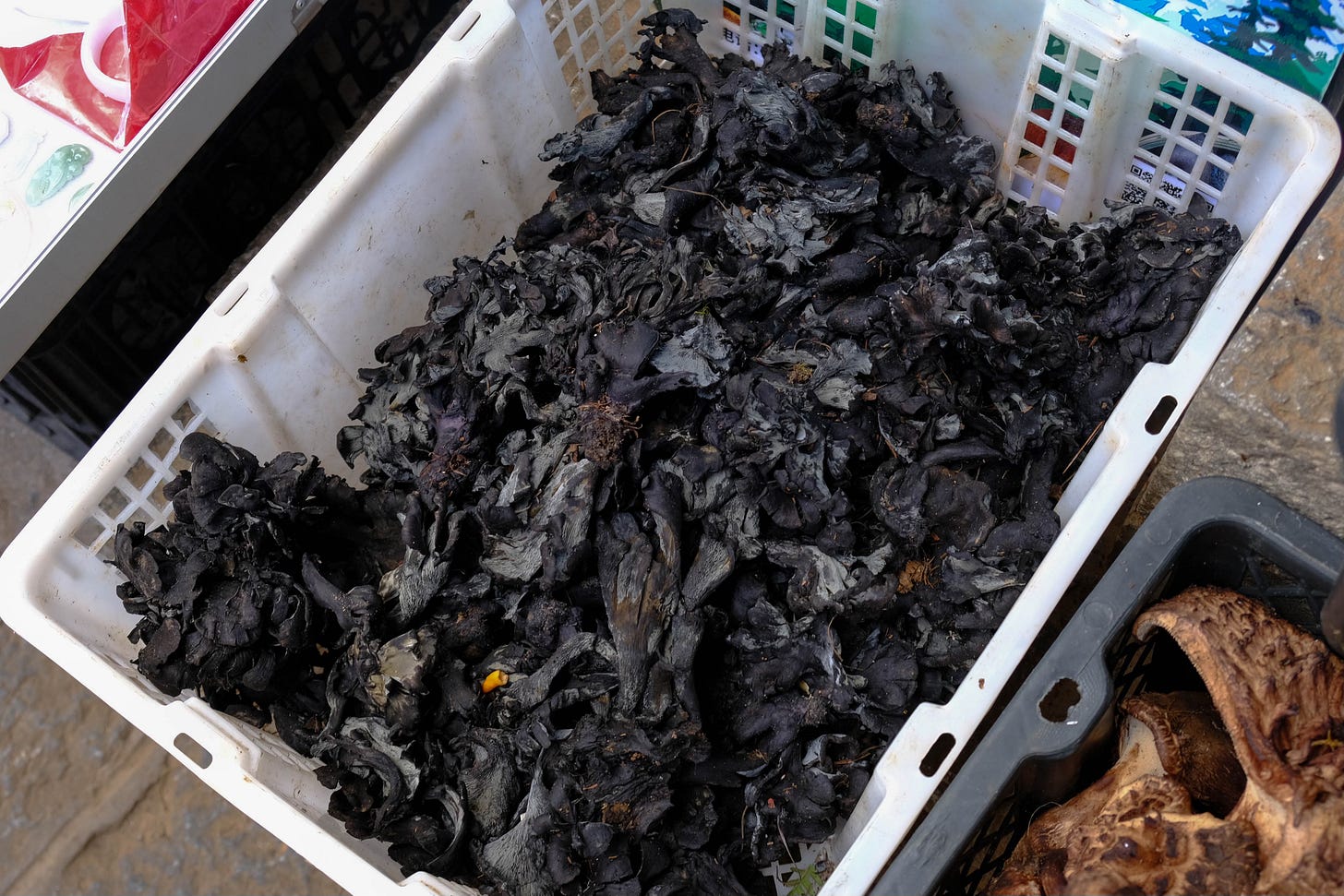
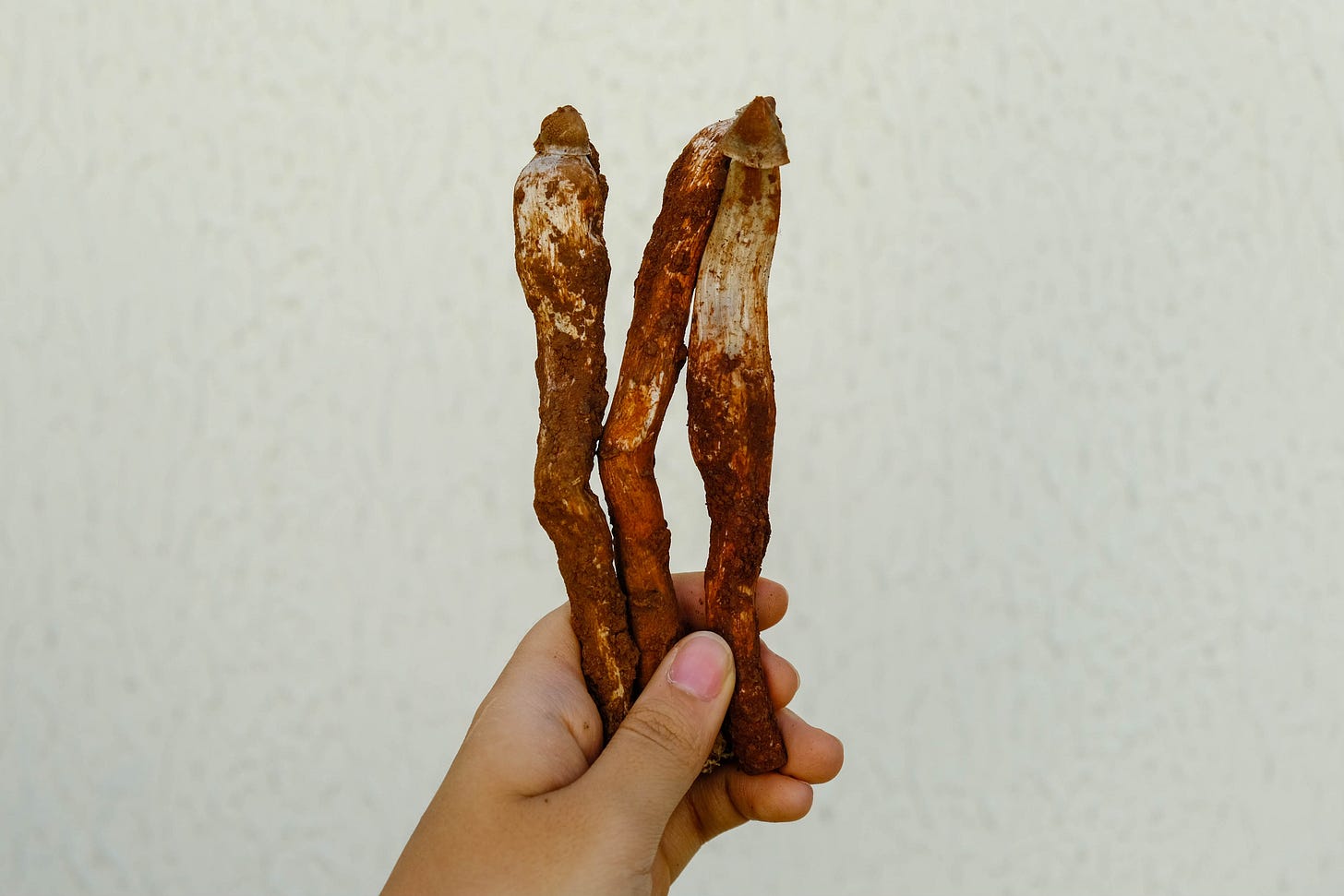




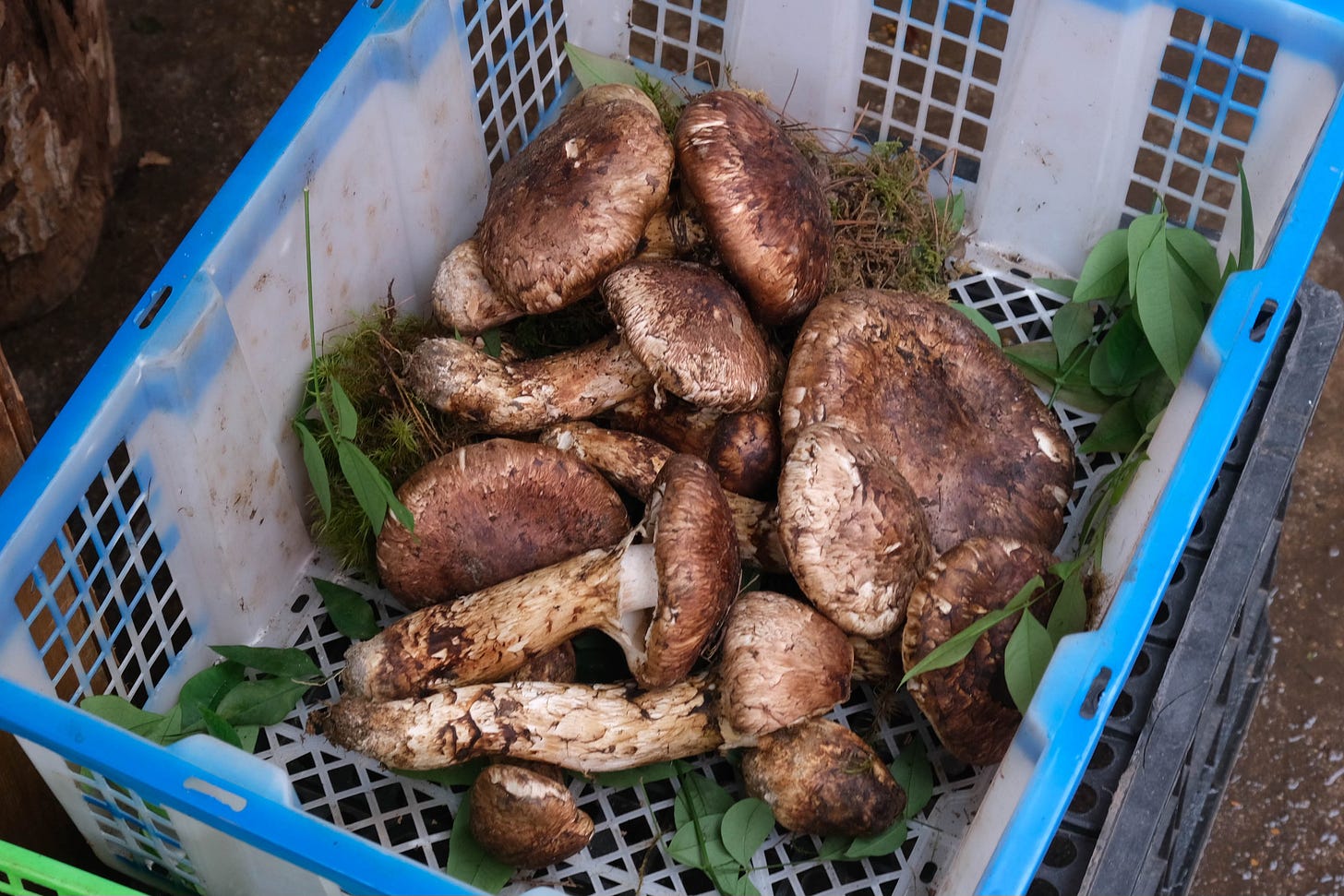


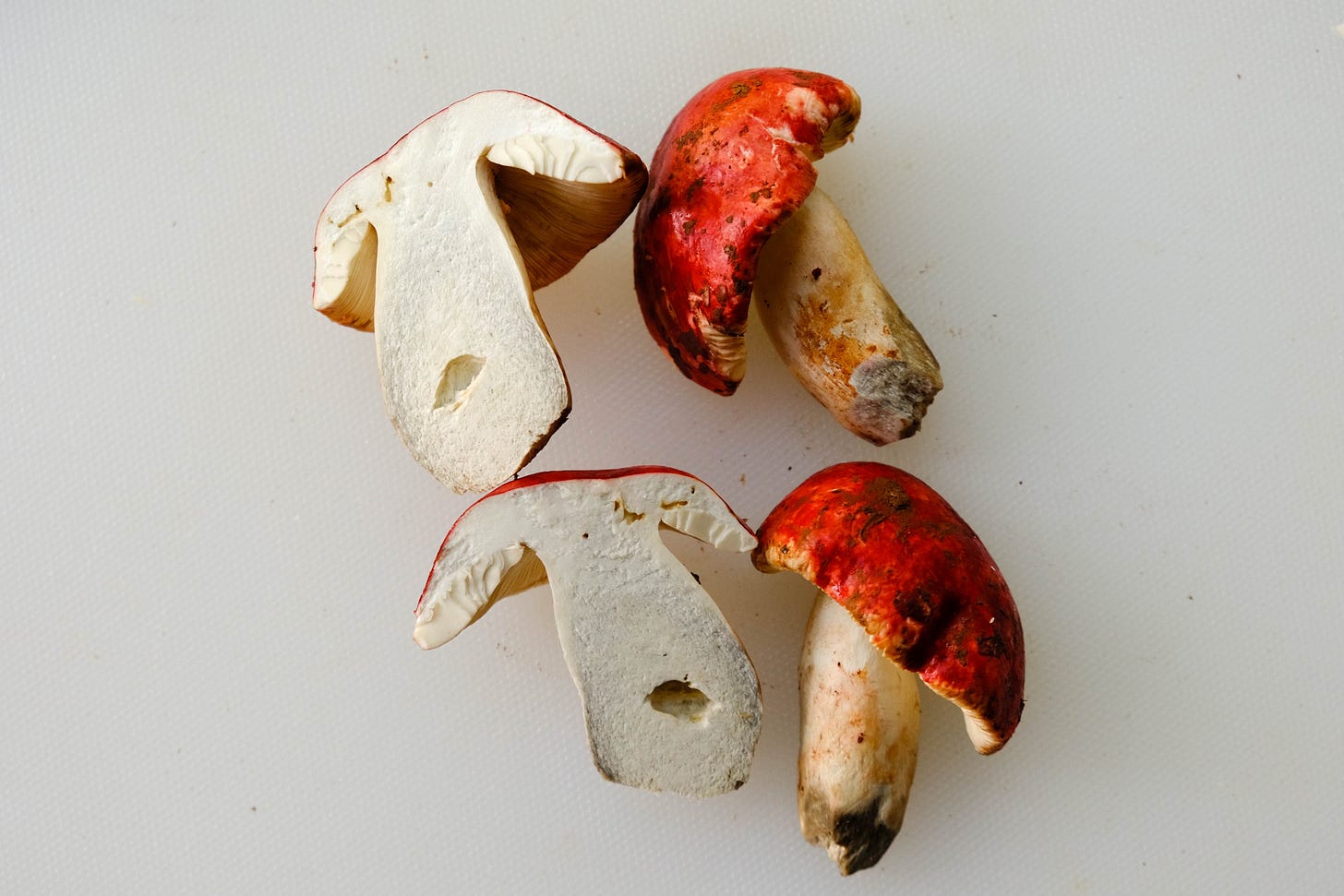
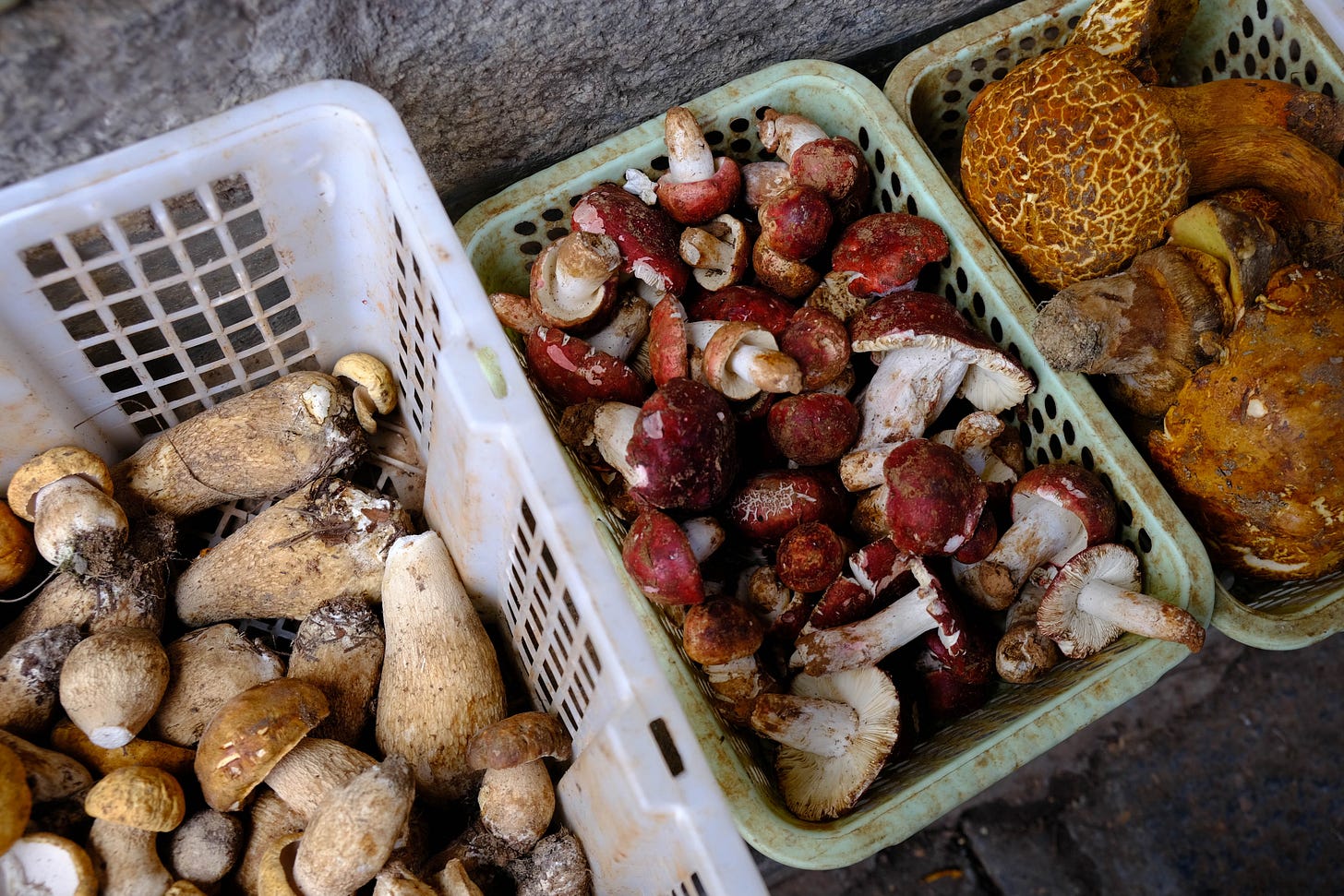







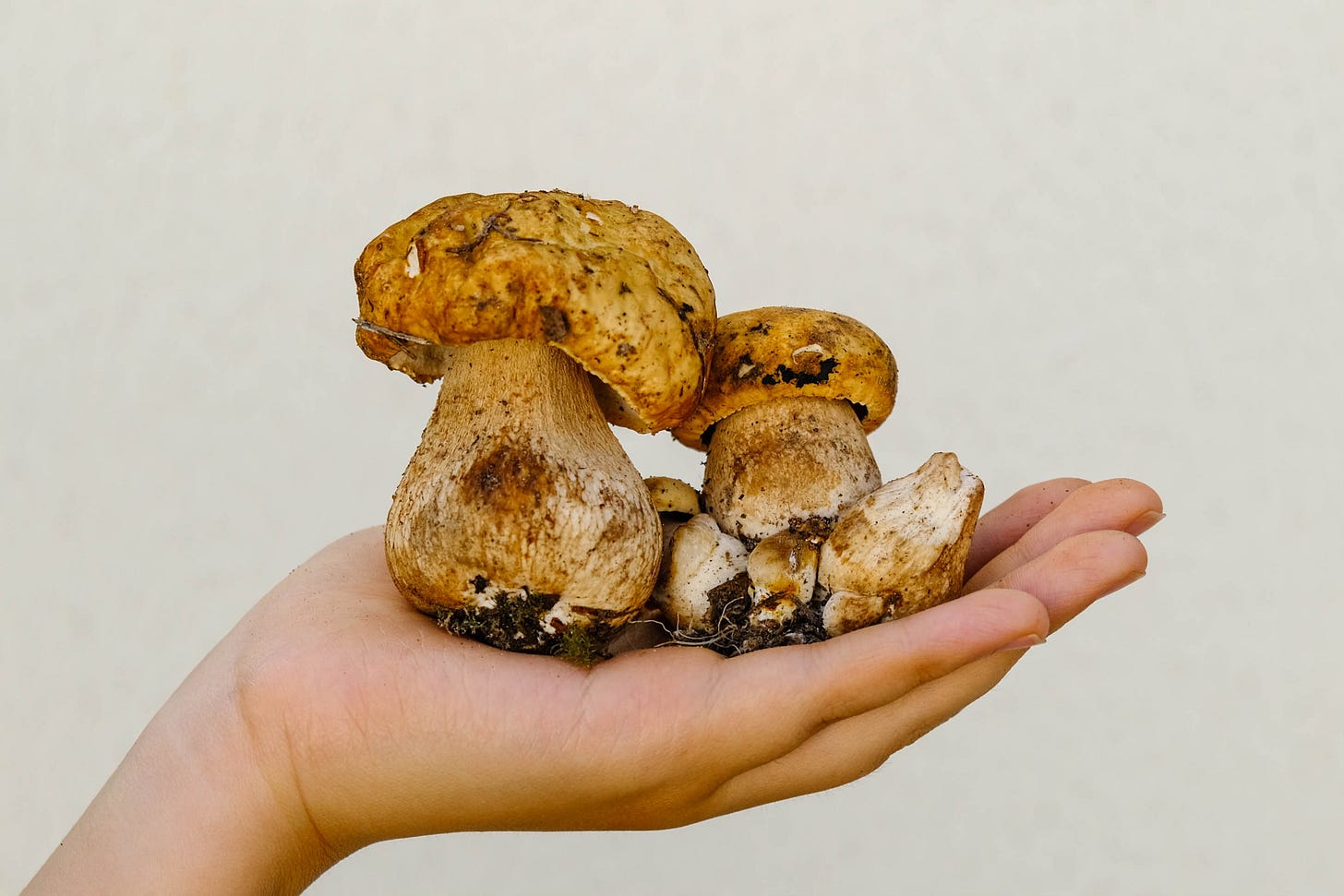
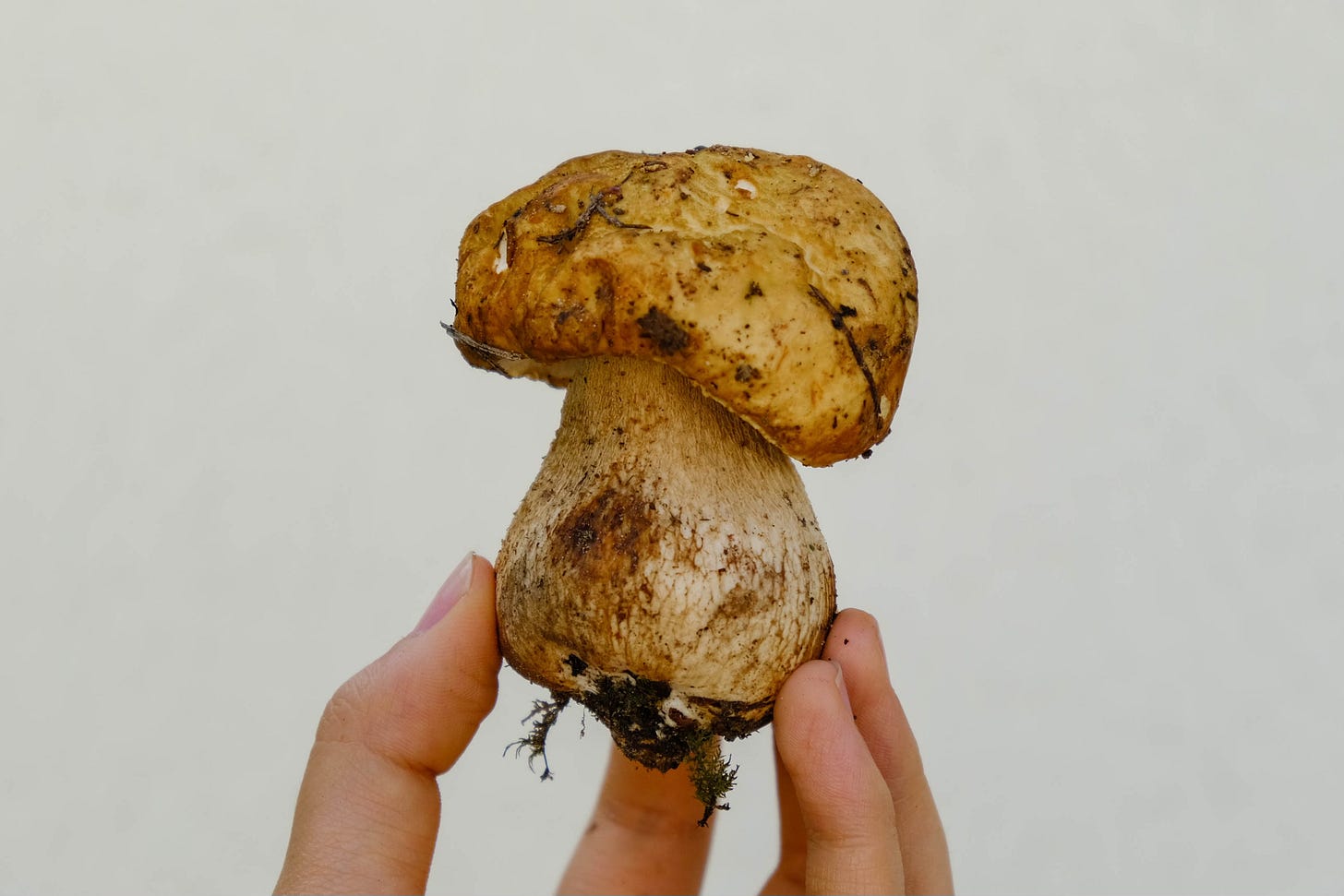

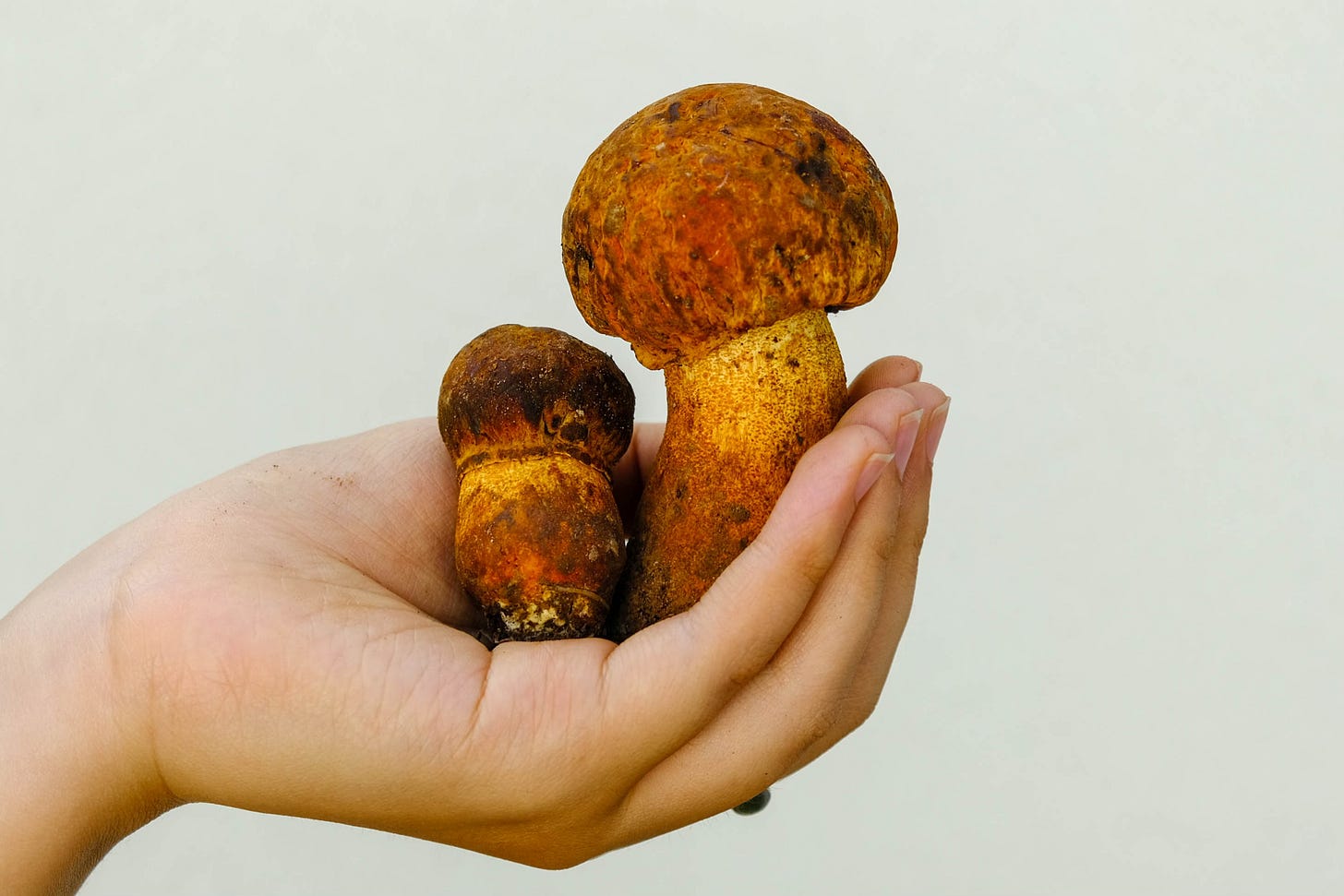

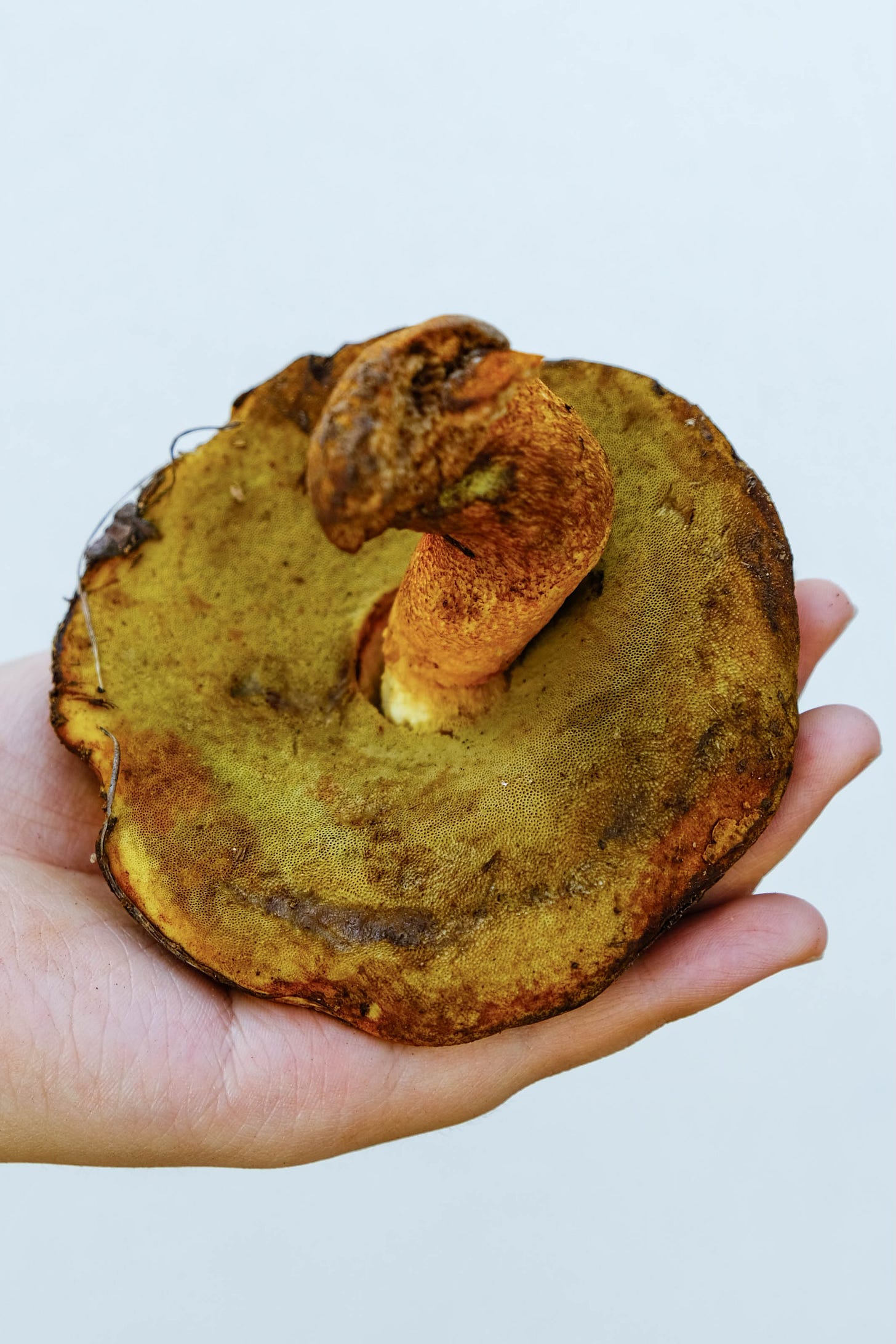
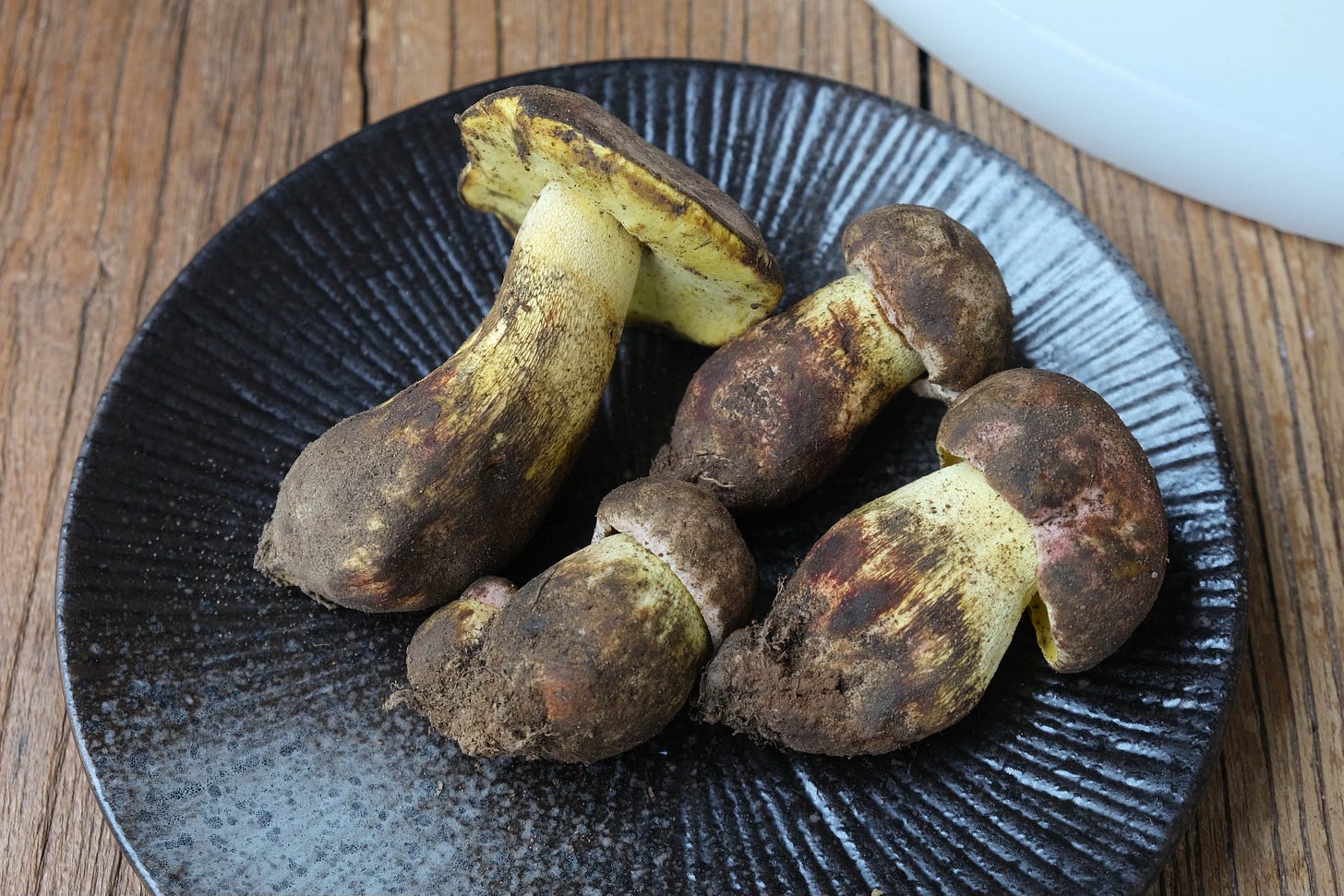



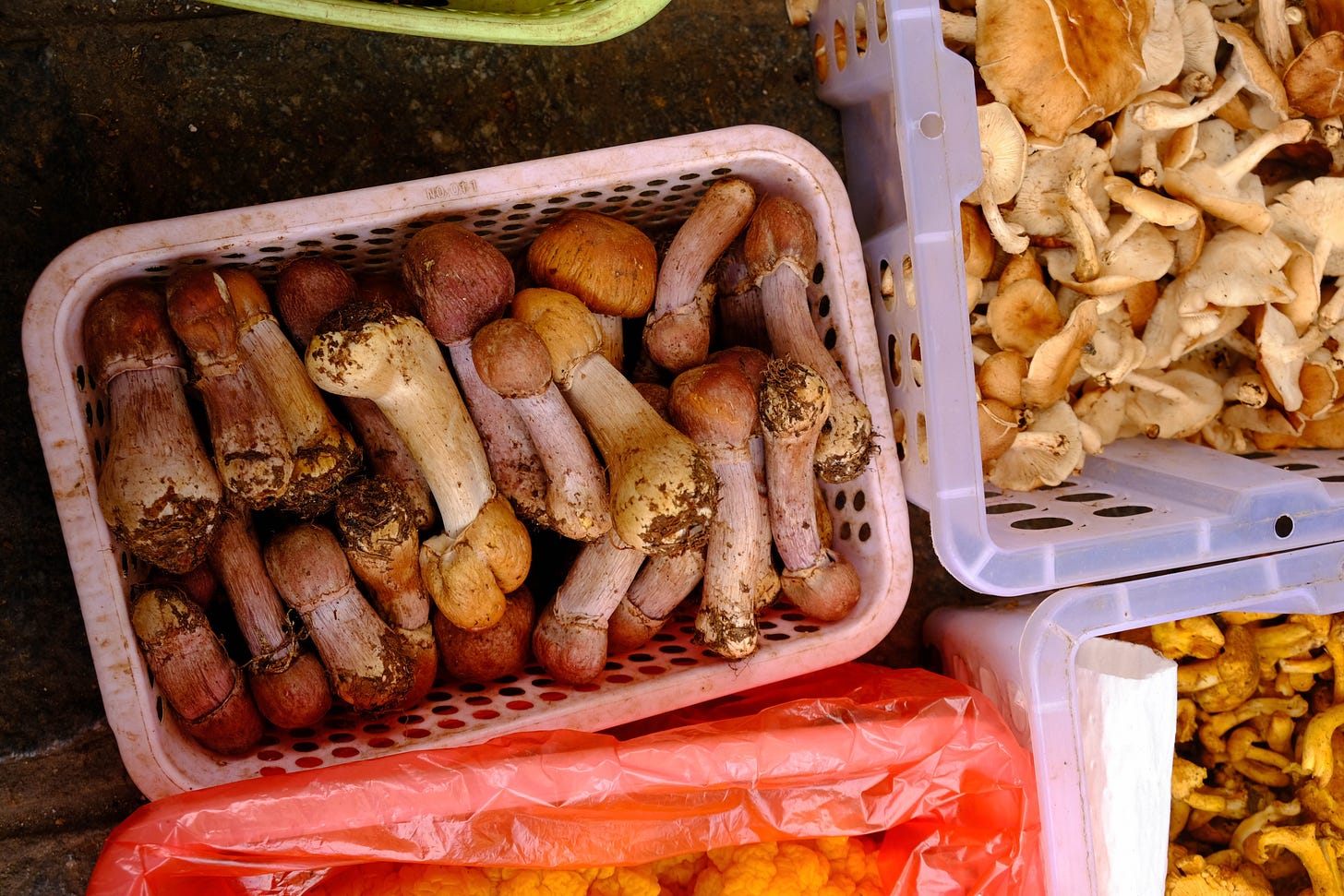


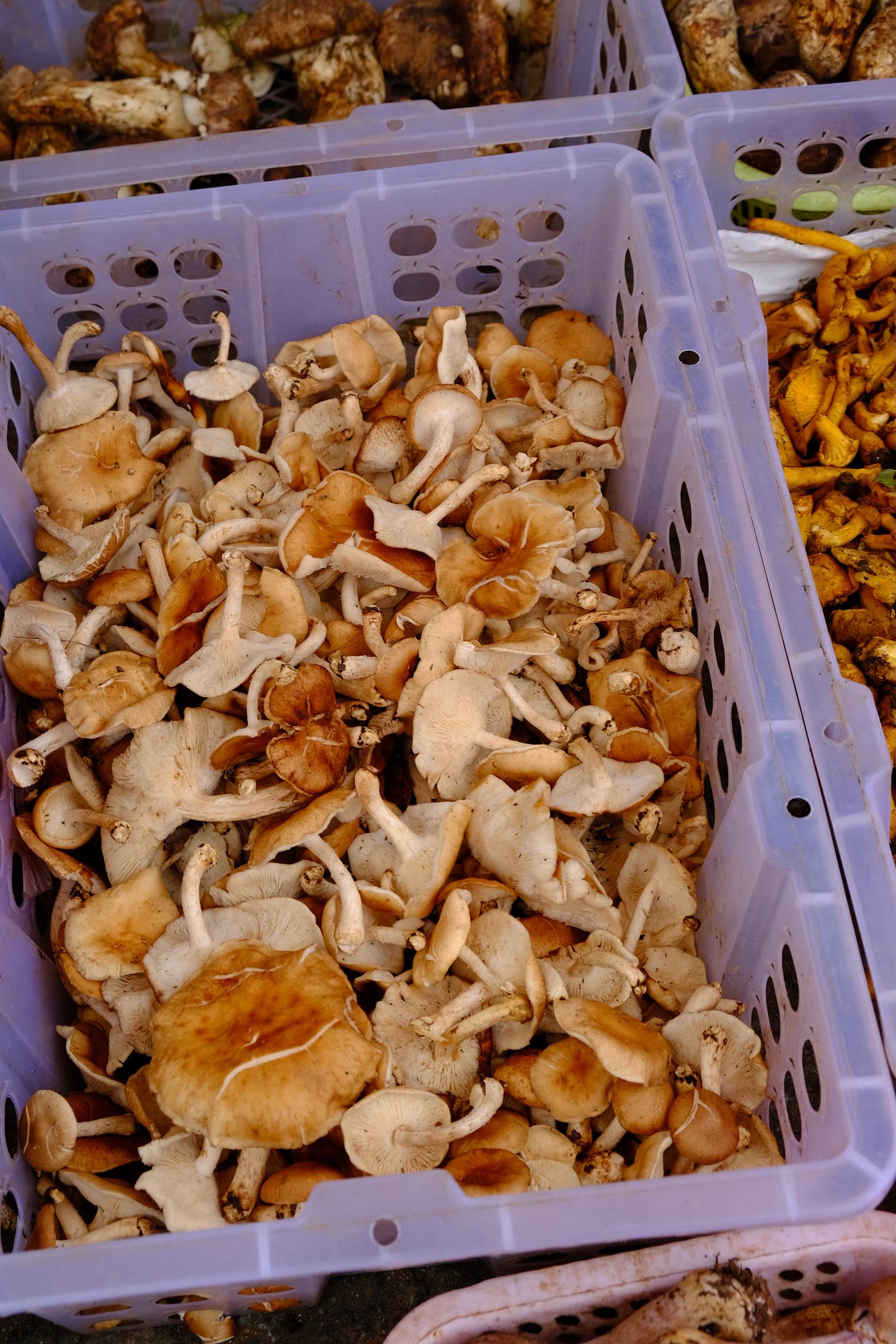
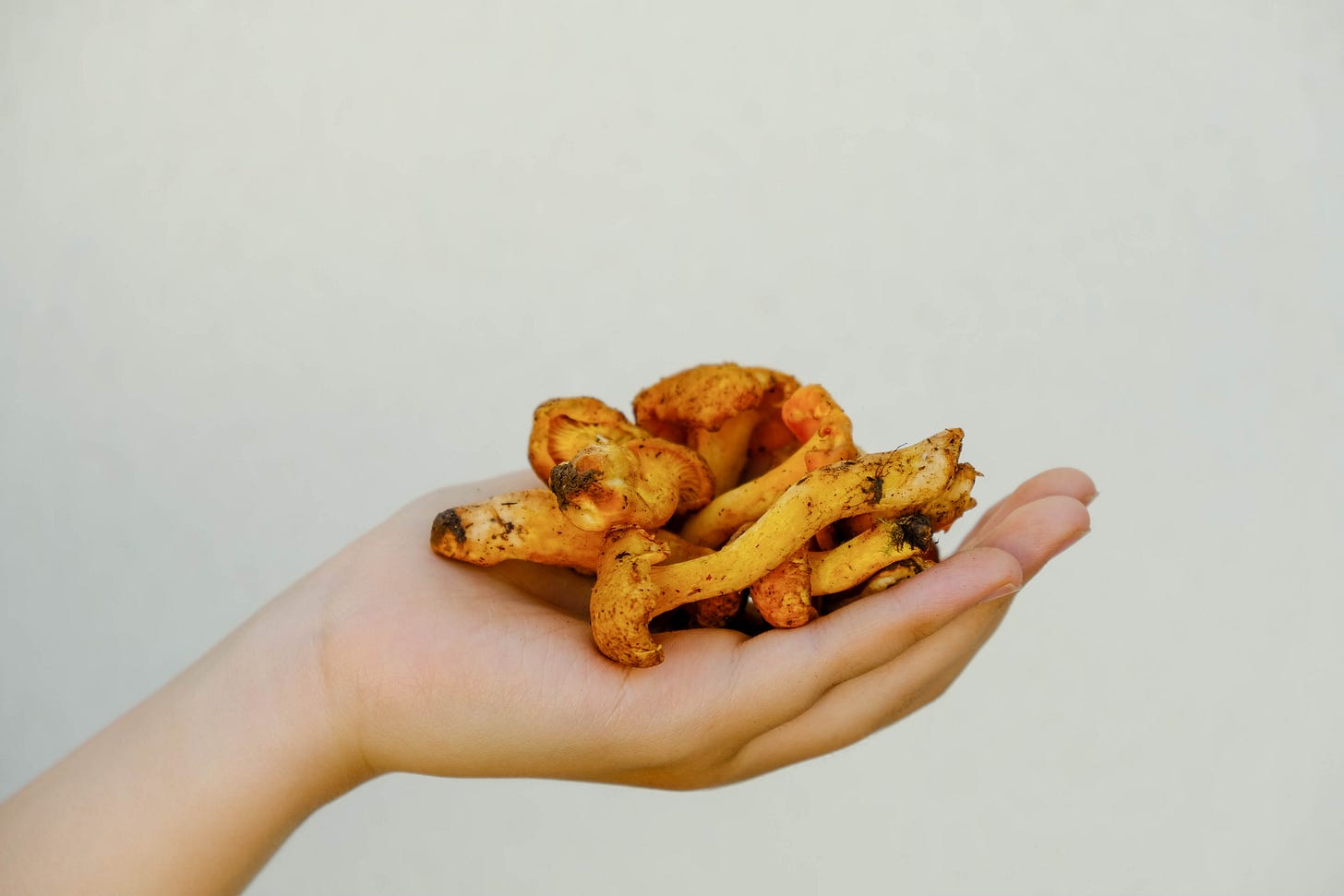
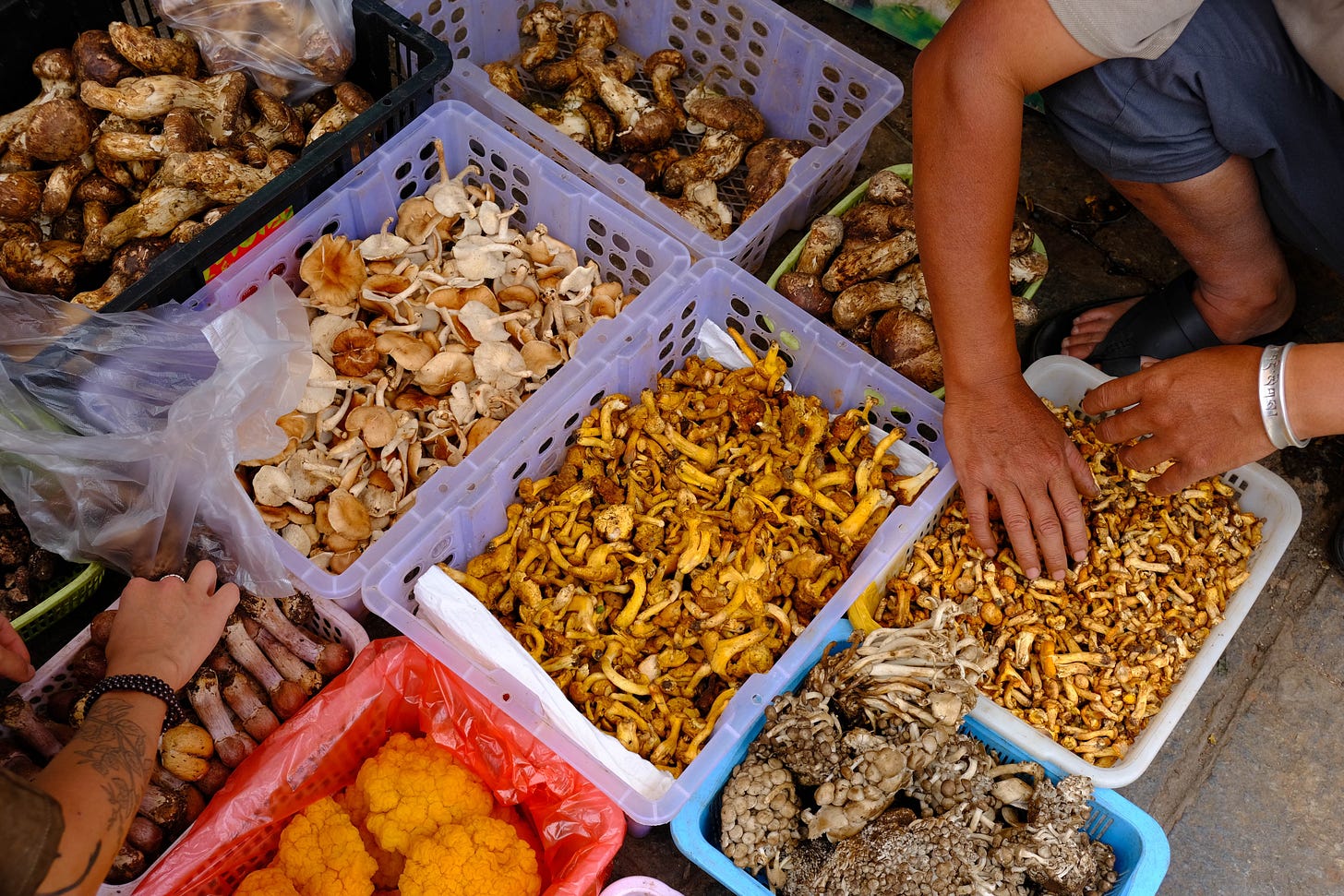






Fantastic pictures!
have a good break! :)